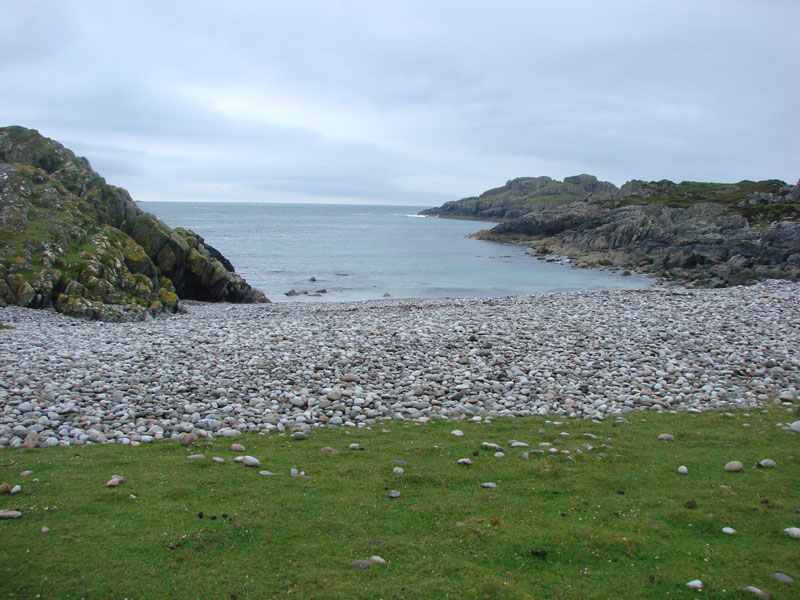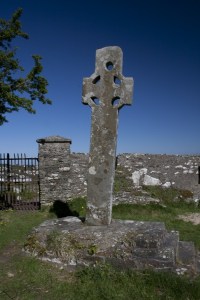Colum Cille
So much has been written elsewhere about the famous St Columba that the reader will not want to read yet another 'regurgitation' of the various opinions concerning the Saint's biography. Instead, we present here a re-print of an article by Dom. Columba Edmonds, OSB., written whilst he was a monk of the Benedictine Abbey at Fort Augustus in Scotland.1 A considerable amount of questionable 'history' has been written by both Presbyterian and Anglican pens since the Victorian era, much of it in the hope of proving that Columba was 'anti-Rome' and that in his time the Church in Scotland was completely divorced from the Church of Rome. It is this same 'trend' that has resulted in the fable of an independent Celtic Church. I hope that, by reading this article, written by one who bore the Saint's own name, we might be able to redress the balance a little.

Above: St Columba's Bay on Iona.
The Apostolate of St Columba.
Seldom has the belief of any saint been more seriously misrepresented than St Columba's. "He and his followers," says Dr Ledwich, "firmly opposed the errors and superstitions of the Church of Rome."2 Writers later than Ledwich would probably hesitate to express themselves so boldly, yet Dr Lightfoot affirms that "Celtic Christianity grew up a strictly native growth."3 The Celts themselves never dreamed of such folly as to claim "native growth" for their Christianity; had they done so they would have proved that their Christianity was no Christianity at all.
Our Presbyterian friends can easily be imagined asking the question: "Do you really mean to tell us, then, that St Columba was a Roman Catholic? Why, we have been always told that he shaved his head differently from Roman monks, and that he kept Easter on a day which did not coincide with the feast at Rome, therefore he could never have been a Roman Catholic; indeed, not a few of us hold that in his heart he adhered to the opinion of our beloved Knox."
Fortunately for our friends, we have not been left in ignorance concerning St Columba's "Roman" Catholicism, thanks to St Adamnán and other ecclesiastical writers of renown. Despite, therefore, the fact that Presbyterians and Anglicans occasionally venture to name their churches after the Apostle of Caledonia, we do not hesitate to affirm that St Columba had as little to do with Presbyterianism or Anglicanism as the present writer has to do with the administration of the Fiji Islands.
If it can be established from indisputable documentary authority that St Columba and his monks believed in papal supremacy and a host of other doctrines which Protestants describe as "Roman Catholic," then it follows that they were "Roman" Catholics in the modern meaning of that term, and that if they were to revisit the scene of their earthly labours they would find themselves at home, not in the manses and kirks of Established, Free, or United Free, but in monasteries such as Fort Augustus, or in churches of which the priests are in communion with the See of Rome.
But what was St Columba's attitude towards the Holy See? In the absence of direct reference in the Life by Adamnán it may reasonably be inferred from the attitude of his ecclesiatical preceptors. While yet a cleric, Columba was under the tutelage of St Finnian of Moville. This St Finnian not only inherited the traditions of the Irish Church respecting papal authority as embodied in the famous Canon of Armagh, but he had frequented the schools of Candida Casa in Galloway, founded a century before by the papal missionary to Scotland - St Ninian.
While there, Finnian's desires went Romewards, so with wallet [cumdach] and staff he set forth on the journey. Having been received with honour by Pope Pelagius, he remained in the Eternal City for the space of three months, learning apostolical customs and ecclesiastical laws.

Above: The Cooley Cross standing where Moville Monastery was situated.
On returning to Ireland, Finnian carried with him a newly-corrected version of the Bible, the work of St Jerome under the immediate sanction of the Pope. Columba transcribed the Latin psalter from the Roman book, and the copy is still preserved in Dublin.4
It is worthy of note that St Columbanus, in his letter to St Gregory the Great, assumes that the Pope is familiar with the names of Gildas the Briton and Finnian of Moville.5
There is every reason to believe that St Columba's fidelity to St Peter's Chair would equal that of his holy master, and undoubtedly, evidence is not wanting to show that it was so. An ancient Irish Life, dating back to the beginning of the twelfth-century, and quoted by Dr Skene, records a tradition that, before St Columba passed over to Scotland, he too desired to visit Rome, and having set out on his pilgrimage, he arrived at Tours. For some unknown reason he proceeded no farther, but brought back to Ireland a copy of the Gospels that had rested for a century upon the relics of St Martin. That book he left in Derry.6
During the later years of Columba's life, St Gregory the Great occupied St Peter's Chair, and in all probability there were communications between these two holy men. A venerable tradition informs us that on one occasion messengers came from Pope Gregory to Iona, bearing with them as gifts the Cross, known long afterwards as "the great gem of Columkille" (preserved till the sixteenth century), and also the Liber Antiphonarius; in gratitude for which presents Columba sent to Pope Gregory his famous composition commencing "Altus Prosator."7
It seems almost incredible that traditions such as these should have originated as forgeries during later ages. The onus probandi lies on those who make these gratuitous assertions.
That communications with Rome were by no means improbable is clear from what Adamnán informs us concerning St Columba's vision of Citta Nuova, a city of the Roman province. The holy man saw in a vision the destruction of that plae; and not long afterwards he and Lugbe, happening to be in Kintyre, a ship arrived from Gaul bringing the news that everything had happened according to the revelation made to the Saint.8
Then, again, we know from the testimony of Adamnán that the discipline at Iona was in perfect accord with the discipline of the Irish Church. At the time of St Columba, and for years afterwards, Iona drew almost all its subjects from Ireland. We may, therefore, with safety adduce the belief of St Columba, regarding the authority of the See of Rome, from the practice of the Irish Church at that time. In the third Canon of the Penitential of St Cummian9 it is laid down that if a monk should violate celibacy, and refuse to perform condign penance, "the Holy Synod, or the Apostolic See, is to spearate him from the communion and intercourse of Catholics." Cummian, who formulated this Penitential, was not only a fellow-countryman, but a contemporary of St Columba. Now, if in so minute a circumstance as the excommunication of a refractory Irish monk it was necessary for the Apostolic See to pass sentence, it can hardly be imagined that papal jurisdiction was not exercised in more weighty matters.
But our Protestant friends will ask: "Did not Columba come to Scotland without any commission from the Pope, and thus display his independence of Roman jurisdiction?" Bede tells us that "he came to Britain for the purpose of preaching God's Word to the people of the provinces of the Northern Picts."10 Adamnán says that he undertook the journey into Britain "for the love of Christ" - "pro Christo."11 The motives which led him to Scotland were twofold - (1) the conversion of the Northern Picts; (2) the instruction of his fellow countrymen in the Dalriadan colony of Argyle and its adjacent isles. The Dalriadans were to Columba what the Jews of the dispersion were to the Apostle St Paul - his "kinsmen according to the flesh."
This migration to Caledonia by no means severed St Columba's connection with his native land; on the contrary, he revisited it more than once, and took a leading part in Irish affairs.
The year of St Columba's arrival in Scotland was AD.563. The grant of Iona to the Saint and his companions was made by Conall, a kinsman of Columba, and King of Dalriada.
St Columba entered upon his Apostolate as a son of the Irish Church, whose beginnings had been marked with papal approval. Whether the Saint obtained the sanction of Rome before setting out we do not know. Formal or explicit authorisation from the Pope, however, was not required in those times for such a work as Columba undertook. The Popes themselves had always enjoined on the bishops and clergy the positive duty of solicitude for the conversion of their heathen neighbours. The local ecclesiastical authorities, realising this obligation, were free to make their own plans without, however, seeking the direct intervention of the Holy See, though occasionally formal approbation was solicited and obtained.
That such was the case is evident from the Epistles of Pope Gregory the Great to the temporal rulers, through whose dominions St Augustine and his companions were about to pass on their way to preach to the Anglo-Saxons. Pope Gregory (Columba's contemporary) complains to Queen Brunichilda that "the neighbouring bishops [of Britain] have neglected to show any pastoral solicitude towards the Angles," and therefore he is sending Augustine into the missionary field.12 The Pontiff uses almost identical words to Kings Theodoric and Theodebert.13
From these facts it is certain that in coming to Caledonia St Columba was displaying no independence of Rome, but, on the contrary, was carrying into effect the known wishes of the Roman Pontiff. He was fulfilling a plain duty, which the British clergy had wilfully neglected, towards their Anglo-Saxon neighbours.
In passing, it is interesting to note that St Columba had Saxon converts in his community at Iona. Two are mentioned by Adamnán - namely, Genereus and Pily.14 These were not indebted for their faith to the Roman missionaries, who as yet had not arrived in Britain, nor evidently to the British. The Irish clergy and monks had clearly undertaken that duty as opportunity occurred, and for this they are often praised by the Venerable Bede.15
If St Columba has not left us any writing by which to assure us of his fidelity to the See of Peter, he has been fortunate in having a contemporary and fellow-countryman who virtually did this for him. What St Columbanus says we shall presently read; suffice it to say here that he was brought up in those very monastic schools which St Columba had frequented in Ireland. His letters express belief in papal supremacy as strongly and as clearly as if they had been written by Cardinal Logue in the twentieth-century.
Is it likely that St Columba would have repudiated the doctrine of St Columbanus? If of two of my friends, who are Catholics, one says nothing about his belief in papal supremacy, but the other says a great deal, it becomes the duty of the person who maintains they are in conflict to prove his assertion.
St Columba's Life by Adamnán can hardly be called a biography, except that it begins with his birth and ends with his death: it is concerned chiefly with visions and miracles. It certainly does not contain an exhaustive list of the doctrines accepted by the holy Abbot, any more than do the written Lives of more modern Catholic saints; but on this account has anyone the right to affirm that such omissions are equivalent to repudiation? Yet this is practically what so many writers say with regard to St Columba.16
In describing the departure of the Saint from this world, Adamnán testifies that the fame of his holy predecessor was spread far and wide; and he reckons it among the favours granted by God to Columba that, "though he lived in a small and remote island of the British sea, yet his name is honoured, not only throughout the whole of our Ireland and Britain, but even in Spain and Gaul, and the renown of his sanctity has also penetrated beyond the Alpine range into Italy - yea, even to the city of Rome itself, which is the head of all cities."17
To St Columba's disciples the city of Rome was "the head of all cities," not because of its temporal glory, but because of its spiritual pre-eminence. Rome at that time was no longer the throne of the emperors; it had been sacked and laid desolate by invading hordes of barbarians. But St Columba's fellow-countryman, Columbanus, gives us the reason for its pre-eminence in the eyes of the Celtic monks of the sixth-century: "Although Rome is great and renowned, through that Chair alone [St Peter's] is she looked on as great and illustrious among us."18
The Church to which St Columba belonged was, according to Columbanus' own testimony, "closely bound" (devincti) "to St Peter's Chair."19 Can this, it is asked, in the name of truth, be affirmed of any body of Christians at the present day, except of those who are known to the world as "Roman Catholics"? If not, then it follows that St Columbanus, St Columba, and the Church to which they belonged, were "Roman" Catholics; for we are "Roman" Catholic precisely because, like them, we are "closely bound" to St Peter's Chair.
References.
1. Edmonds, Dom. Columba (1906) The Early Scottish Church: Its Doctrine and Discipline. Edinburgh: Sands & Co. pp.148-159.
2. Ledwich, Antiquities of Ireland, as quoted by Smith, John, D.D., Life of Columba, Edinburgh, 1897. p.12.
3. Lightfoot Leaders in the Northern Church, p.7
4. Montalembert, "Monks of the West," iii. 127. As to any dispute between Columba and Finnian, it is evident, says Lanigan (ii. p.148) that it did not occur; and the two saints retained their mutual friendship till death (Adamnán L. iii. c.4. Fowler's ed.).
5. Migne, P.L., vol. lxxx. pp. 262, 263; also Dialog. S. Greg. iii. c.q.
6. "Celtic Scotland," vol. ii. p.483
7. Dr Reeves' "Vita St Columbæ," p. 318; also Moran's "Irish Saints," p. 105"
8. Fowler's Adamn. L. i. c.28.
9. Migne, P.L., lxxxvii. p.985
10. Hist. Eccl. L. iii. c.4
11. Præf. II. ad L.i. c.1
12. Haddan and Stubbs, vol. iii. p.10
13. Ibid.
14. Fowler's Adamnan, L. iii. c.10 and c.22
15. Lanigan, Eccl. Hist. ii. p.174
16. Ancient annalists have recorded every detail and circumstance of controversies affecting minor points of discipline - e.g. Easter and the tonsure. Can it be conceived they would have passed over in silence questions involving fundamental principles, such as a rejection of papal authority?
17. There existed at this time a British colony in Spain (Gallicia) governed by a Celtic bishop who was suffragan to the Archbishop of Braga - a striking testimony of the unity of faith existing between the Celts and Spaniards - and it is probable that the knowledge of St Columba reached Spain through this colony from Britain. (Haddan and Stubbs, ii. P.I. p.99); Fowler's Adamn. L. iii. c.23
18. Migne, P.L., vol. ixxx. p. 279
19. Ibid.
small(transp).png)
